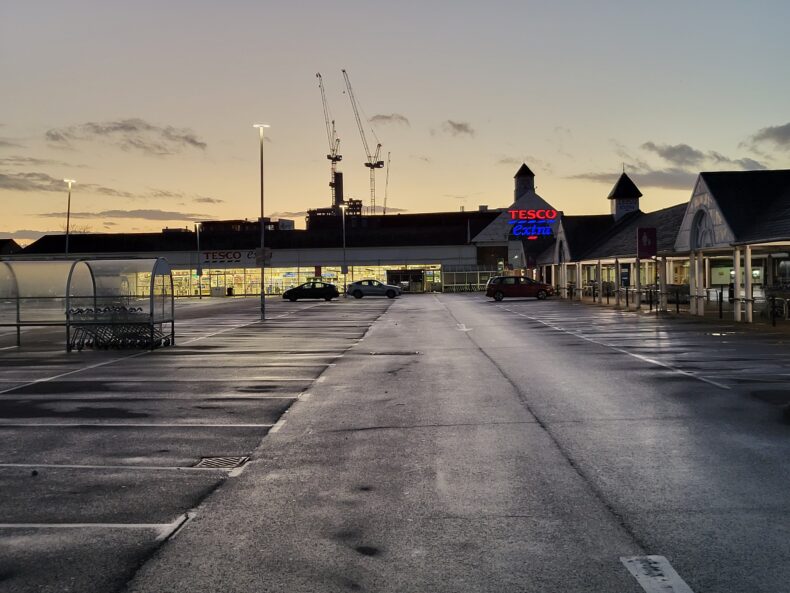In a new series, CapX is celebrating the way our planning system tries its very best to save the country from affordable housing or decent infrastructure. This week, the strange case of Lorimer Village and Tesco’s ‘Toxic Towers’…
Where is it? Next to the Elizabeth line station in Goodmayes, out in the badlands where east London gives way to Essex.
What’s there now? A Tesco superstore and a whopping great car park.
Who wants to build what? A partnership between Weston Homes and the aforementioned branch of Tesco has planned ‘Lorimer Village’: 14 blocks containing 1,400 homes, 35% affordable, plus a new primary school, a vast quantity of solar panels, a load of new green spaces and even a new entrance to the station (although TfL have muttered about not being able to afford to maintain it, so, hmmm).
What’s stopping them? Well… nothing actually. The heights of the blocks have been cut, the number of homes reduced to 1,280, and a new community hall added to the plan. But despite campaigners’ best efforts it’s going ahead.
It’s week two and you’re already looking at schemes NIMBYs couldn’t block? I’m trying to make a point. One of the things NIMBYs like to say is that the planning system should be ‘brownfield first’ – that we shouldn’t put at risk even a single blade of grass until we’ve used up every single square inch of previously developed land available.
Actually, a lot of brownfield land isn’t great for housing – it’s at risk of flooding, miles from anywhere, requires decontamination from previous industrial use, or, in the case of Barking Riverside, all three.
This, though, is brownfield in an urban area, conveniently wedged between a main road and a railway line we’ve just spent £18bn providing with fast and frequent trains to central London. (The Elizabeth Line was planned with almost no reference to housing supply because it was the Noughties and ‘housing crisis’ still meant ‘slight wobble in prices’, but I digress.)
The scheme will allow the London Borough of Redbridge to meet a year’s housing need and then some on a single site. The plan even starts with building a replacement supermarket, so there won’t be a day when the locals have to find a Sainsbury’s or something. It’s perfect.
So I’m guessing everyone loves it and the joy among the population of Goodmayes has been unconfined? Sit down, this may come as a shock. Campaigners have dubbed the scheme the ‘Tesco Toxic Towers’, and a 2019 petition against it gathered over 3,300 signatures. Its objections ran the gamut from the potentially reasonable (more traffic; overcrowded local public services) to more tenuous (reduced privacy for current residents thanks to high rises; the local park already gets quite busy) to utterly insane (new residents will inevitably attract pests and will give the area’s pre-existing criminal underclass ‘another place to ply their trade’).
Nonetheless, after fierce debate, the council backed the scheme as the best way to meet housing need. Which was when the local MP, Labour’s Sam Tarry, weighed in, demanding the mayor of London call the scheme in for review, and (my favourite bit, this) blocking people who criticised him for it on Twitter.
Good to see a Corbynite MP standing up to over-mighty developers and also anyone who might benefit from increased housing supply. His complaint was that the towers were too tall, and that he’d prefer social rented homes to affordable market housing.
I’d prefer to be a handsome billionaire. Also if you cut the height, you reduce the number of homes, and the developer will reduce its affordable housing commitments. Anyway, the mayor refused and Tarry’s been de-selected.
Why ‘toxic’ towers, by the way? Oh, campaigners backed by four political parties and the local TUC have been worried about sticking flats and a school between a polluted main road and the Great Eastern Mainline – they took another petition to Downing Street, and appealed to the High Court, where they lost – but the council has decided it doesn’t want the school anyway.
I don’t mean to confuse things here, but air pollution sounds… bad? Yes, but what are we meant to do, just stop building near roads until we’ve sorted them out?
Actually, so does over-development. But this is what happens when ballooning housing need meets artificially constrained land supply: when decent sites do come up, planners and developers alike inevitably want to squeeze them. If you don’t want to do that, we’re going to need more land, which either means knocking some of the homes we’ve already got down for densification purposes, or it means greenfield development.
Oh we shouldn’t build on greenfield. Not while there’s brownfield available. I’m so glad we spent £18bn on a giant new tube line without allocating a single square inch of new land for housing, I really am.

The aforementioned branch of Tesco

The neighbouring road
Click here to subscribe to our daily briefing – the best pieces from CapX and across the web.
CapX depends on the generosity of its readers. If you value what we do, please consider making a donation.


